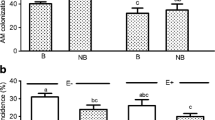Abstract
The arbuscular mycorrhizal (AM) non-host plants mustard, sugar beet, lupin and the AM host plant cucumber were used as test plants. Cucumber plants were grown either in the absence of the AM fungus (AMF) Glomus mosseae or in a split-root system, with one side mycorrhizal and one side non-mycorrhizal. Root exudates of the AM non-host plants, the non-mycorrhizal cucumber plants and the mycorrhizal and the non-mycorrhizal side of the split-root system of mycorrhizal cucumber plants were collected and applied to cucumber plants inoculated with the AMF. Root exudates of non-mycorrhizal cucumber plants showed a significant stimulatory effect on root colonization, whereas root exudates from the mycorrhizal and the non-mycorrhizal sides of a split-root system of a mycorrhizal cucumber plant did not show this stimulatory effect and were even slightly inhibitory. Root exudates of the two AM non-host plants mustard and sugar beet significantly reduced root colonization in cucumber plants, whereas no such effect was observed when root exudates of the AM non-host plant lupin were applied.

Similar content being viewed by others
References
Akiyama K, Matsuoka H, Hayashi H (2002) Isolation and identification of a phosphate deficiency-induced C-glycosylflavonoid that stimulates arbuscular mycorrhiza formation in melon roots. Mol Plant Microbe Interact 15:334–340
Avio L, Sbrana C, Giovannetti M (1990) The response of different species of Lupinus to VAM endophytes. Symbiosis 9:321–323
Becard G, Piché Y (1989) Fungal growth stimulation by CO2 and root exudates in vesicular-arbuscular symbiosis. Appl Environ Microbiol 55:2320–2325
Cordier C, Pozo MJ, Barea JM, Gianinazzi S, Gianinazzi-Pearson V (1998) Cell defence responses associated with localized and systemic resistance to Phytophthora parasitica induced in tomato by an arbuscular mycorrhizal fungus. Mol Plant Microbe Interact 11:1077–1028
El-Atrach F, Vierheilig H, Ocampo JA (1989) Influence of non-host plants on vesicular-arbuscular mycorrhizal infection of host plants and on spore germination. Soil Biol Biochem 21:161–163
Elias KS, Safir GR (1987) Hyphal elongation of Glomus fasciculatus in response to root exudates. Appl Environ Microbiol 53:1928–1933
Gianinnazzi-Pearson V, Branzanti B, Gianinazzi S (1989) In vitro enhancement of spore germination and early hyphal growth of a vesicular-arbuscular mycorrhizal fungus by host root exudates and plant flavonoids. Symbiosis 7:243–255
Giovannetti M (2000) Spore germination and pre-symbiotic mycelial growth. In: Kapulnik Y, Douds DD (eds) Arbuscular mycorrhizas: physiology and function. Kluwer, Dordrecht, pp 47–68
Giovannetti M, Mosse B (1980) An evaluation of techniques for measuring vesicular-arbuscular mycorrhizal infection in roots. New Phytol 84:489–500
Giovannetti M, Sbrana C (1998) Meeting a non-host: the behaviour of AM fungi. Mycorrhiza 8:123–130
Graham JH (1982) Effect of citrus exudates on germination of chlamydospores of the vesicular-arbuscular mycorrhizal fungus Glomus epigaeum. Mycologia 74:831–835
Morandi (1996) Occurrence of phytoalexins and phenolic compounds on endomycorrhizal interactions, and their potential role in biological control. Plant Soil 185:241–251
Nagahashi G, Douds DD (2000) Partial separation of root exudate components and their effects upon the growth of germinated spores of AM fungi. Mycol Res 104:1453–1464
Newman EI (1966) A method of estimating the total length of root in a sample. J Appl Ecol 3:139–145
Norman JR, Hooker JE (2000) Sporulation of Phytophthora fragariae shows greater stimulation by exudates of non-mycorrhizal than mycorrhizal strawberry roots. Mycol Res 104:1069–1073
Oba H, Tawaraya K, Wagatsuma T (2002) Inhibition of pre-symbiotic hyphal growth of the arbuscular mycorrhizal fungus Gigaspora margarita by root exudates of Lupinus spp. Soil Sci Plant Nutr 48:117–120
Pinior A, Wyss U, Piché Y, Vierheilig H (1999) Plants colonized by AM fungi regulate further root colonization by AM fungi through altered root exudation. Can J Bot 77:891–897
Pozo MJ, Cordier C, Dumas-Gaudot E, Gianinazzi S, Barea JM, Azcon-Aguilar C (2002) Localized versus systemic effect of arbuscular mycorrhizal fungi on defense responses to Phytophthora infection in tomato plants. J Exp Bot 53:525–534
Schreiner RP, Koide RT (1993) Antifungal compounds from the roots of mycotrophic and non-mycotrophic plant species. New Phytol 123:99–105
Smith S, Read DJ (1997) Mycorrhizal symbiosis. Academic Press, London
Tawaraya K, Watanabe S, Yoshida E, Wagatsuma T (1996) Effect of onion (Allium cepa) root exudates on the hyphal growth of Gigaspora margarita. Mycorrhiza 6:57–59
Tawaraya K, Hashimoto K, Wagatsuma T (1998) Effect of root exudate fractions from P-deficient and P-sufficient onion plants on root colonisation by the arbuscular mycorrhizal fungus Gigaspora margarita. Mycorrhiza 8:67–70
Vierheilig H, Piché Y (2002) Signalling in arbuscular mycorrhiza: facts and hypotheses. In: Buslig B, Manthey J (eds) Flavonoids in cell functions. Kluwer, New York, pp 23–39
Vierheilig H, Alt M, Mäder P, Boller T, Wiemken A (1995) Spreading of Glomus mosseae, a vesicular-arbuscular mycorrhizal fungus, across the rhizosphere of host and non-host plants. Soil Biol Biochem 27:1113–1115
Vierheilig H, Iseli B, Alt M, Raikhel N, Wiemken A, Boller T (1996) Resistance of Urtica dioica to mycorrhizal colonization: a possible involvement of Urtica dioica agglutinin. Plant Soil 183:131–136
Vierheilig H, Bago B, Albrecht C, Poulin MP, Piché Y (1998a) Flavonoids and arbuscular-mycorrhizal fungi. In: Manthey JA, Buslig BS (eds) Flavonoids in the living system. Plenum, New York, pp 9–33
Vierheilig H, Coughlan AP, Wyss U, Piché Y (1998b) Ink and vinegar, a simple staining technique for arbuscular mycorrhizal fungi. Appl Environ Microbiol 64:5004–5007
Vierheilig H, Garcia-Garrido JM, Wyss U, Piché Y (2000a) Systemic suppression of mycorrhizal colonization of barley roots already colonized by AM fungi. Soil Biol Biochem 32:589–595
Vierheilig H, Maier W, Wyss U, Samson J, Strack D, Piché Y (2002b) Cyclohexenone derivative- and phosphate-levels in split-root systems and their role in the systemic suppression of mycorrhization in precolonized barley plants. J Plant Physiol 157:593–599
Acknowledgements
This work was supported by a grant from the Natural Sciences and Engineering Research Council of Canada. The authors thank Dr. P. Schausberger (BOKU, Vienna) for help with the statistical analyses.
Author information
Authors and Affiliations
Corresponding author
Rights and permissions
About this article
Cite this article
Vierheilig, H., Lerat, S. & Piché, Y. Systemic inhibition of arbuscular mycorrhiza development by root exudates of cucumber plants colonized by Glomus mosseae . Mycorrhiza 13, 167–170 (2003). https://doi.org/10.1007/s00572-002-0219-0
Received:
Accepted:
Published:
Issue Date:
DOI: https://doi.org/10.1007/s00572-002-0219-0




